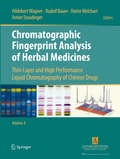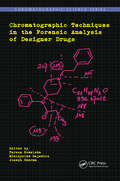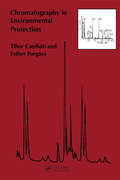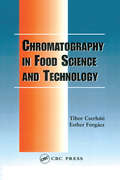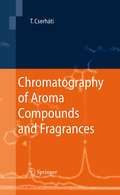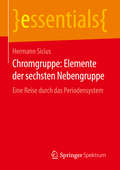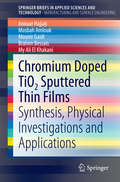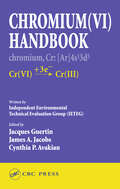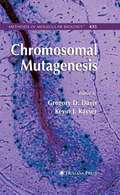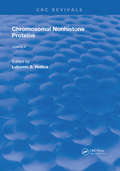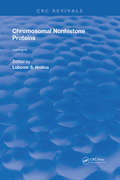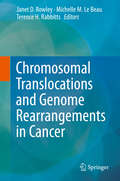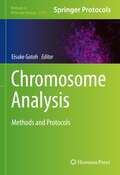- Table View
- List View
Chromatographic Fingerprint Analysis of Herbal Medicines Volume IV: Thin-Layer and High Performance Liquid Chromatography of Chinese Drugs
by Dieter Melchart Hildebert Wagner Rudolf Bauer Anton StaudingerVolume IV of this manual provides an overview of the analytical investigation of numerous additional Chinese Herbal Drugs, which are most commonly used in Traditional Chinese Medicine (TCM). The detailed chromatographic analysis of the main compounds is illustrated in coloured TLC-photographs and HPLC-peak profiles. Further bioactive properties, pharmacological and biological activities of all single herbal drugs, as well as their therapeutic applications are discussed. Together with Volumes I - III this current volume represents the most comprehensive overview to analytical studies of those herbal drugs on the market and therefore serves as a must-have manual for researchers and laboratories dedicated to TCM. The quality proof of the investigation meets the standard of the European Drug Regulatory Authority.
Chromatographic Processes: Modeling, Simulation, and Design
by Roger-Marc NicoudAddressing all aspects of the design, modeling and simulation of chromatographic processes, this result-oriented primer provides a practical guide to all the necessary approaches, methodologies and tools. Beginning with key definitions and concepts, it builds up from the most simple to the most complex situations, including multicomponent systems, non-uniform velocity profiles, bed instability, particle size distributions, and the influence of complex environments on chromatographic process design. In addition to covering classical approaches, it introduces efficient tools for investigating chromatographic processes, such as the 'Russian-Lego' approach for linear systems, phenomenological models, and specific shortcuts for deriving the key properties of industrial processes. With an emphasis on real-world problems and applications, step-by step modeling design guidelines, and detailed exercises for self-assessment, this is a must-have guide for practitioners and researchers working in chemical, biochemical, food and pharmaceutical engineering.
Chromatographic Techniques in the Forensic Analysis of Designer Drugs (Chromatographic Science Series)
by Joseph Sherma Teresa Kowalska Mieczyslaw SajewiczThere is a dramatic rise of novel drug use due to the increased popularity of so-called designer drugs. These synthetic drugs can be illegal in some countries, but legal in others and novel compounds unknown to drug chemistry emerge monthly. This thoughtfully constructed edited reference presents the main chromatographic methodologies and strategies used to discover and analyze novel designer drugs contained in diverse biological materials. The methods are based on molecular characteristics of the drugs belonging to each individual class of compounds, so it will be clear how the current methods are adaptable to future new drugs that appear in the market.
Chromatography
by Charles W. Gehrke Robert L. WixomLeading researchers discuss the past and present of chromatographyMore than one hundred years after Mikhail Tswett pioneered adsorption chromatography, his separation technique has developed into an important branch of scientific study. Providing a full portrait of the discipline, Chromatography: A Science of Discovery bridges the gap between early, twentieth-century chromatography and the cutting edge of today's research.Featuring contributions from more than fifty award-winning chromatographers, Chromatography offers a multifaceted look at the development and maturation of this field into its current state, as well as its importance across various scientific endeavors. The coverage includes:Consideration of chromatography as a unified science rather than just a separation methodKey breakthroughs, revolutions, and paradigm shifts in chromatographyProfiles of Nobel laureates who used chromatography in their research, and the role it playedRecent advances in column technologyChromatography's contributions to the agricultural, space, biological/medical sciences; pharmaceutical science; and environmental, natural products, and chemical analysisFuture trends in chromatographyWith numerous references and an engaging series of voices, Chromatography: A Science of Discovery offers a diverse look at an essential area of science. It is a unique and invaluable resource for researchers, students, and other interested readers who seek a broader understanding of this field.
Chromatography
by Elsa Lundanes Tyge Greibrokk Léon ReubsaetFinally a book on chromatography which is easy to grasp for undergraduates and technicians; covers the area in sufficient depth while still being concise. The book includes all recent technology advances and has core textbook features further improving the learning experience.This book is the perfect introduction into a methodology which is the underlying principle of the vast majority of separation methods worldwide. Everyone working in a lab environment must be familiar with the basis of these technologies and Tyge Greibrokk, Elsa Lundanes and Leon Reubsaet succeed in delivering a text which is easy to read for undergraduates and laboratory technicians, and covers the area in sufficient depth while still being concise. The book includes all recent technology advances and has core textbook features further improving the learning experience.Importantly, the text does not only cover all major modern chromatography technology (thin layer, gas, high pressure liquid, and supercritical fluid chromatography) but also related methods, in particular electrophoretic technologies.
Chromatography in Environmental Protection
by Tibor Cserhati Esther ForgacsChromatography has been developed as a powerful and rapid technique for the separation of compounds with highly similar molecular characteristics, even from complicated matrices. Due to their excellent separation characteristics and Versatility, chromatographic methods have found growing acceptance and application in environmental protection fo
Chromatography in Food Science and Technology
by Tibor Cserhati Esther ForgacsoCompilation and evaluation of the newest applications of chromatography for food science and technologyoEnumeration of chromatographic methods and critical discussion of resultsThis book presents a unique collection of up-to-date chromatographic methods for the separation and quantitative determination of carbohydrates, lipids, proteins, peptides, amino acids, vitamins, aroma and flavor compounds in a wide variety of foods and food products. Chromatography in Food Science and Technology presents a concise evaluation of existing chromatographic methods used for many food and food product macro and microcomponents. Chromatographic methods are compiled according to the character of the food components to be separated.The book's chapters deal separately with the different classes of food components, presenting both gas and liquid chromatographic methods used for their determination, and discussing the advantages and disadvantages of each.Unlike other references, Chromatography in Food Science and Technology is entirely devoted to the use of chromatography for food analysis, and focuses on practical, food-related examples. It treats the theoretical aspects of chromatography briefly, to the degree that the information helps the use and development of new analytical methods for the separation of any kind of food components.
Chromatography of Aroma Compounds and Fragrances
by Tibor CserhátiThis is the only comprehensive survey of chromatographic methods for the analysis of aroma compounds and fragrances. A unique feature of the book are the extensive tables with relevant data. This will help significantly to choose an appropriate method, and to compare its characteristics with that of other methods. Coverage of applications includes food products, essential oils, as well as environmental samples. Tibor Cserháti is a recognized member of the separation science community with long-standing publishing experience. He is author or coauthor of six books and more than 490 scientific papers.
Chromatography of Natural, Treated and Waste Waters
by T.R CromptonChromatography of Natural, Treated and Waste Waters is the first book to bring together information of a range of chromatographic techniques in all types of water, precipitation to sewage effluents. Organic and inorganic compounds, cations, anions and elements are all discussed. Particular attention is paid to multi compound analysis of water, and
Chromatography/Fourier Transform Infrared Spectroscopy and its Applications (Practical Spectroscopy Ser. #10)
by Robert WhiteThis book is intended to serve as an up-to-date reference source for those familiar with chromatography/Fourier transform infrared spectroscopy (FT-IR) methods and as an introduction to techniques and applications for those interested in future uses for chromatography/FT-IR.
Chromatography: Principles and Instrumentation
by Mark F. VithaProvides students and practitioners with a solid grounding in the theory of chromatography, important considerations in its application, and modern instrumentation. Highlights the primary variables that practitioners can manipulate, and how those variables influence chromatographic separations Includes multiple figures that illustrate the application of these methods to actual, complex chemical samples Problems are embedded throughout the chapters as well as at the end of each chapter so that students can check their understanding before continuing on to new sections Each section includes numerous headings and subheadings, making it easy for faculty and students to refer to and use the information within each chapter selectively The focused, concise nature makes it useful for a modular approach to analytical chemistry courses
Chromgruppe: Eine Reise durch das Periodensystem (essentials)
by Hermann SiciusHermann Sicius stelltin diesem essential dieElemente der sechsten Nebengruppe (Chromgruppe) ausf#65533;hrlich vor. Er zeigt, dassdie Elemente dieser Gruppe chemisch meist relativ reaktionstr#65533;ge sind undregelm#65533;#65533;ige Abstufungen ihrer Eigenschaften zeigen. So nehmen vom Chrom zumWolfram Dichte, Schmelz- und Siedepunkte zu, die Reaktivit#65533;t leicht ab. Chrom,Molybd#65533;n und Wolfram entdeckte man Ende des 18. Jahrhunderts, das nur k#65533;nstlichdarstellbare Seaborgium erst etwa 200 Jahre sp#65533;ter. Molybd#65533;n ist z. B. Bestandteilsehr harter St#65533;hle, Wolfram wurde f#65533;r Wendeln von Gl#65533;hlampen verwendet.
Chromium -VI Reagents: Synthetic Applications (SpringerBriefs in Molecular Science)
by P. S. Raghavan S. SundaramChromic acid and chromium oxide are the two versatile Cr(VI) oxidants known to organic chemists for decades. The introduction of the Core's reagent , viz: pyridinium chlorochromate, in 1975 followed by the publications on several Cr(VI) oxidizing agents containing the -onium chromates and halochromates in the last three decades have very much changed the chemistry of oxidations with Chromium VI. Several of these new reagents have been shown to be mild so that they can be handled easily and the reacton products may also be controlled. Some of them are highly selective oxidants for positions like allylic hydroxylic group, etc., and some other are highly regioselective. The information on more than 36 such reagents reported in various internationally reputed journals spanning about 280 references have been collected and provided in this book in such a manner that it will be very useful for professionals, researchers, teachers and graduate students working in organic synthesis.
Chromium Doped TiO2 Sputtered Thin Films: Synthesis, Physical Investigations and Applications (SpringerBriefs in Applied Sciences and Technology)
by Anouar Hajjaji Mosbah Amlouk Mounir Gaidi Brahim Bessais My Ali El KhakaniThis book presents co-sputtered processes ways to produce chrome doped TiO2 thin films onto various substrates such as quartz, silicon and porous silicon. Emphasis is given on the link between the experimental preparation and physical characterization in terms of Cr content. Moreover, the structural, optical and optoelectronic investigations are emphasized throughout. The book explores the potencial applications of devices based on Cr doped TiO2 thin films as gas sensors and in photocatalysis and in the photovoltaic industry. Also, this book provides extensive leads into research literature, and each chapter contains details which aim to develop awareness of the subject and the methods used. The content presented here will be useful for graduate students as well as researchers in materials science, physics, chemistry and engineering.
Chromium(VI) Handbook
by James A. Jacobs Jacques Guertin Cynthia P. AvakianPut together by a team of scientists, engineers, regulators, and lawyers, the Chromium(VI) Handbook consolidates the latest literature on this topic. The broad scope of this book fills the need for a comprehensive resource on chromium(VI), improving the knowledge of this contaminant at a time when the extent and degree of the problem is still being
Chromogranins: from Cell Biology to Physiology and Biomedicine (UNIPA Springer Series)
by Tommaso Angelone Maria Carmela Cerra Bruno TotaThe volume is designed to provide an integrated overview of the results from the last fifteen years of research on Chromogranins in relation to cell biology, physiology and biomedicine. The different chapters highlight novel activities of these proteins, including their role in granule biogenesis, hormone co-storage, stimulus-processing-secretion coupling, autonomic sympathetic/parasympathetic balance, immune and cardiocirculatory function, and the response to stress. Biomedical aspects are also illustrated with focus on the prognostic and diagnostic significance of Chromogranin in the presence of tumors, cardiovascular diseases and inflammatory conditions. The volume is of interest for laboratory and clinical scientists, PhD and Post-doc students that will be inspired to go deep inside the molecular, biochemical, physiological, pharmacological and clinical aspects of these fascinating multifaceted proteins.
Chromosomal Instability in Cancer Cells (Recent Results in Cancer Research #200)
by Thomas Ried B. Michael GhadimiThis issue of Recent Results in Cancer Research presents a comprehensive review of current understanding of chromosomal instability in cancer and of strategies to use this information for better treatment of patients with cancer. Cancer is a disease of the chromosomes, and chromosomal instability in cancer disrupts gene function by either inactivating tumor suppressor genes or activating growth-promoting oncogenes. The chromosomal basis for these aberrations is either translocations, which change the integrity of genes, or abnormal numbers of chromosomes, a condition referred to as aneuploidy, which results in abnormal gene expression levels. Such structural or numerical chromosomal aberrations are specific for distinct tumor entities. The degree of chromosomal instability and the degree of intratumor heterogeneity have profound consequences for disease outcome and for therapeutic stratification.
Chromosomal Mutagenesis (Methods in Molecular Biology #1239)
by Shondra M. Pruett-MillerThis new edition explores current and emerging mutagenesis methods focusing specifically on mammalian systems and commonly used model organisms through comprehensive coverage and detailed protocols. Since the first edition, major advances and discoveries have made chromosomal mutagenesis a widely used technique and one that is available to any molecular biology laboratory, and this collection provides detailed protocols, case-studies, and reviews from thought-leaders in the field. Written in the highly successful Methods in Molecular Biology series format, chapters include introductions to their respective topics, lists of the necessary materials and reagents, step-by-step, readily reproducible laboratory protocols, and tips on troubleshooting and avoiding known pitfalls. Authoritative and fully updated, Chromosomal Mutagenesis, Second Edition aims to help speed scientific discovery and aid in the next advances in the field.
Chromosomal Mutagenesis (Methods in Molecular Biology #435)
by Kevin J. Kayser Greg DavisGreat disparities exist between organisms with regard to the relative ease of chromosomal mutagenesis and manipulation. In Chromosomal Mutagenesis, a team of experts provide a variety of chromosomal manipulation techniques, including insertional gene disruptions, gene knockouts, stimulated homologous recombination techniques and other novel tools, for both prokaryotic and eukaryotic organisms, and attempt to expand the genetic toolbox beyond model organisms. Following the format of the highly successful Methods in Molecular BiologyTM format, each chapter offers step-by-step laboratory instructions, lists of the necessary equipment and reagents, and tips on troubleshooting and avoiding known pitfalls. Comprehensive and cutting-edge, Chromosomal Mutagenesis covers state-of-the-art techniques that are staged to expand, if not revolutionize, genetic analysis in the long neglected and relevant cell types.
Chromosomal Nonhistone Protein: Volume I: Biology
by L. S. HnilicaThe first volume of the Chromosomal Nonhistone Proteins treatise presents a summary of the many attempts in the literature to correlate changes in chromosomal histone proteins specificity and metabolism with transcriptional regulations in eukaryotic cells.
Chromosomal Nonhistone Protein: Volume II: Immunology
by L. S. HnilicaThe second volume of the Chromosomal Nonhistone Proteins treatise is dedicated in its entirety to the immunobiology of these proteins. Since immunological methods are adding rapidly to our knowledge of the specificity and intranuclear localization of chromosomal nonhistone proteins, a collection of chapters dealing with various aspects of this important area was judged appropriate.
Chromosomal Nonhistone Protein: Volume III: Biochemistry
by L. S. HnilicaThe third volume of the Chromosomal Nonhistone Proteins treatise deals with the isolation and analysis of chromosomal proteins in general with specific features of these proteins in particular. In addition to the high mobility group (HMG) proteins, post synthetic modifications of chromosomal nonhistone proteins are discussed, together with some of their enzymatic properties DNA binding.
Chromosomal Nonhistone Protein: Volume IV: Structural Associations
by L. S. HnilicaThe fourth and last volume of Chromosomal Nonhistone Proteins sequence attempts to confront these macromolecules with the major structural elements of the cell nucleus (with the exception of nucleosomes which will be treated separately in a later treatise). Proteins of the chromosomes, nucleoli, nuclear membrane, RNP particles, and nuclear matrix are described in detail.
Chromosomal Translocations and Genome Rearrangements in Cancer
by Michelle M. Le Beau Janet D. Rowley Terence H. RabbittsThis volume collates world experts' insights into the molecular biology of cancer chromosomes, their abnormalities and the subsequent cellular consequences. Exploring themes involving oncogenes, such as by chromosomal translocations, other genome rearrangements and somatic mutations, this book is a review of the field of cancer genetics that presages a new era, as whole genome sequencing becomes more accessible. The work begins with a look at historical themes, such as the analysis of metaphase chromosomes using microscopy and staining techniques, advances in which provided our first broad glimpse into the genetic anatomy of a malignant cell. Readers will learn about the application of DNA molecular cloning techniques in the 1980s, that led to the identification of the genes involved in the Philadelphia and Burkitt's lymphoma chromosomal translocations, solidifying the role of oncogenes and tumour suppressor genes in cancer aetiology via chromosomal alterations and which launched a field in cancer genetics. Subsequent chapters bring the reader up to date by reviewing recent developments in the field, with dedicated sections on leukaemia/lymphoma, sarcomas and epithelial tumours. Contributions feature numerous colour tables and illustrations and this volume will provide a basis for understanding cancer chromosomes for many years to come.
Chromosome Analysis: Methods and Protocols (Methods in Molecular Biology #2519)
by Eisuke GotohThis volume provides essential and fundamental protocols on manipulation chromosome. Chapters details methods on the preparation of mitotic chromosome, chromosome aberration, micronucleus (MN), comet assay, karyotyping, Fluorescent in situ hybridization (FISH), premature chromosome condensation (PCC), immunohistochemistry (IHC) staining, new generation sequencing technology and new chromosome concepts, such as epigenetic and its cause of cancer are presented. Written in the format of the highly successful Methods in Molecular Biology series, each chapter includes an introduction to the topic, lists necessary materials and reagents, includes tips on troubleshooting and known pitfalls, and step-by-step, readily reproducible protocols. Authoritative and cutting-edge, Chromosome Analysis: Methods and Protocols aims to be a useful and practical guide to new researchers and experts looking to expand their knowledge.
